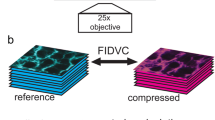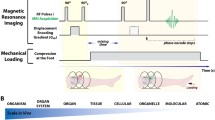Abstract
The objectives of this study were to develop a method to quantitate the displacement and strain fields within articular cartilage during equilibrium confined compression, and to use the method to determine the variation of the equilibrium confined compression modulus with depth from the articular surface in bovine cartilage. The method made use of fluorescently labeled chondrocyte nuclei as intrinsic fiducial markers. Articular cartilage was harvested from the patellofemoral groove of adult bovines and trimmed to rectangular blocks 5 mm long, 0.76 mm wide, and 500 μm deep with the articular surface intact. Test specimens were stained with the DNA binding dye Hoechst 33258, placed in a custom confined compression chamber, and viewed with an epifluorescence microscope equipped for video image acquisition. Image processing was used to localize fluorescing chondrocyte nuclei in uncompressed and compressed (∼ 17%) speciments, allowing determination of the intratissue displacement profile. Strain was determined as the slope of linear regression fits of the displacement data in four sequential 125-μm-thick layers. Equilibrium strains varied 6.1-fold from the articular surface through 500 μm of cartilage depth, with the greatest compressive strain in the superficial 125-μm layer and the least compressive strain in the two deepest 125-μm layers. Thus, the four successive 125-μm layers have moduli that are 0.44 (superficial), 1.07, 2.39, and 2.67 (deep), times the apparent modulus for a 500 μm thick cartilage sample assumed to be homogeneous.
Similar content being viewed by others
References
Armstrong, C. G., and V. C. Mow. Variations in the intrinsic mechanical properties of human articular cartilage with age, degeneration, and water content.J. Bone Joint Surg. Am. 64:88–94, 1982.
Bean, H. S., H. E. McGannon, C. W. Briggs, L. D. Kunsman, C. L. Carlson, H. E. Bacon, S. Yorsiadis, H. M. Werner, C. H. de Zeeuw, A. F. Baldo, W. L. Gamble, K. A. Roe, M. I. Smith, and A. S. Vernick. Materials of engineering. In: Marks’ Standard Handbook for Mechanical Engineers, edited by E. A. Avallone and T. Baumeister. New York: McGraw-Hill, 1987, pp. (6)1-(6)206.
Broom, N. D., and D. B. Meyers. A studys of the structural response of wet hyaline cartilage to various loading situations.Connect. Tissue. Res. 7:227–237, 1980.
Buckwalter, J., E. Hunziker, L. Rosenberg, R. Coutts, M. Adams, and D. Eyre. Articulars cartilage: Composition and structure. In: Injury and Repair of the Musculoskeletal Soft Tissues, edited by S. L.-Y. Woo and J. A. Buckwalter. Park Ridge, IL: American Academy or Orthopedic Surgeons, 1988, pp. 405–425.
Buschmann, M. D., and A. J. Grodzinsky. A molecular model of proteoglycan-associated electrostatic forces in cartilage mechanics.J. Biomech. Eng. 117:179–192, 1995.
Eisenberg, S. R., and A. J. Grodzinsky. Electrokinetic micromodel of extracellular matrix and other polyelectrolyte networks.Physicochem. Hydrodynam. 10:517–539, 1988.
Farquhar, T., P. R. Dawson, and P. A. Torzilli. A microstructural model for the anisotropic drained stiffness of articular cartilage.J. Biomech. Eng. 112:414–425, 1990.
Frank, E. H., A. J. Grodzinsky, N. G. Kavesh, and S. E. Eisenberg. Continuum models for electrokinetic transduction in articular cartilage: homogeneous and layered material properties. In: Advances in Bioengineering, edited by N. A. Langrana. New York: ASME, 1985, pp. 5–6.
Frank, E. H., A. J. Grodzinsky, T. J. Koob, and D. R. Eyre. Streaming potentials: A sensitive index of enzymatic degradation in articular cartilage.J. Orthop Res. 5:497–508, 1987.
Fung, Y. C., Biomechanics: Mechanical Properties of Living Tissues, New York: Springer-Verlag, 1981, pp. 406–413.
Gore, D. M., G. R. Higginson, and R. J. Minns. Compliance of articular cartilage and its variation through the thickness.Phys. Med. Biol. 28:233–247, 1983.
Grodzinsky, A. J., and E. H. Frank. Electromechanical and physicochemical regulation of cartilage strength and metabolism. In: Connective Tissue Matrix, Vol. 2, Topics in Molecular and Structural Biology, edited by D. W. L. Hukins. Boca Raton, FL: CRC Press, 1990, pp. 91–126.
Guilak, F. Cytoskeletal regulation of nuclear deformation and intracellular prestress in chondrocytes.ASME Adv. Bioeng. BED-28:213–214, 1994.
Guilak, F., B. C. Meyer, A. Ratcliffe, and V. C. Mow. The effects of matrix compression on proteoglycan metabolism in articular cartilage explants.Osteoarthritis Cartilage. 2:91–101, 1994.
Guilak, F., and V. C. Mow. Determination of the mechanical response of the chondrocyte in situ using finite element modeling and confocal microscopy.ASME Adv. Bioeng. BED-22:21–24, 1992.
Guilak, F., A. Ratcliffe, and V. C. Mow. Chondrocyte deformation and local tissue strain in articular cartilage: A confocal microscopy study.J. Orthop. Res. 13:410–421, 1995.
Haugland, R. P., Molecular Probes Handbook of Fluorescent Probes and Research Chemicals. Eugene, OR: Molecular Probes, 1992.
Holmes, M. H., W. M. Lai, and V. C. Mow. Singular perturbation analysis of the nonlinear, flow-dependent com-pressive stress relaxation behavior of articular cartilage.J. Biomech. Eng. 107:206–218, 1985.
Hunziker, E. B.. Articular cartilage structure in humans and experimental animals. In: Articular Cartilage and Osteoarthritis, edited by K. E. Kuettneret al., New York: Raven Press, 1992, pp. 183–199.
Intaglietta, M., and W. R. Tompkins. On-line measurement of microvascular dimensions by television microscopy.J. Appl. Physiol. 32:546–551, 1972.
Khala, P. S., and S. R. Eisenberg. Direct measurement of axial and radial confining stresses in articular cartilage during uniaxial confined compression.Trans. Orthop. Res. Soc. 20:519, 1995.
Kim, Y. J., R. L. Sah, A. J. Grodzinsky, A. H. K. Plaas, and J. D. Sandy. Mechanical regulation of cartilage biosynthetic behavior: Physical stimuli.Arch. Biochem. Biophys. 311:1–12, 1994.
Kim, Y. J., R. L. Y. Sah, J. Y. H. Doong, and A. J. Grodzinsky. Fluorometric assay of DNA in cartilage explants using Hoechst 33258.Anal. Biochem. 174:168–176, 1988.
Kwan, M. K., W. M. Lai, and V. C. Mow. A finite deformation theory for cartilage and other soft hydrated connective tissues. I. Equilibrium results.J. Biomech. 23:145–155, 1990.
Lai, W. M., J. S. Hou, and V. C. Mow. A triphasic theory for the swelling and deformation behaviors of articular cartilage.J. Biomech. Eng. 113:245–258, 1991.
Lee, R. C., E. H. Frank, A. J. Grodzinsky, and D. K. Roylance. Oscillatory compressional behavior of articular cartilage and its associated electromechanical properties.J. Biomech. Eng. 103:280–292, 1981.
Lipshitz, H., R. Etheredge, and M. J. Glimcher. Changes in the hexosamine content and swelling ratio of articular cartilage as functions of depth from the surface.J. Bone Joint Surg. Am. 58:1149–1153, 1976.
Macirowski, T., S. Tepic, and R. W. Mann. Cartilage stresses in the human hip joint.J. Biomech. Eng. 116:10–18, 1994.
Maroudas, A.. Physico-chemical properties of articular cartilage. In: Adult Articular Cartilage, edited by M. A. R. Freeman. Tunbridge Wells, England: Pitman, 1979, pp. 215–290.
Maroudas, A., and P. Bullough. Permeability of articular cartilage.Nature 219:1260–1261, 1968.
Maroudas, A., H. Muir, and J. Wingham. The correlation of fixed negative charge with glycosaminoglycan content of human articular cartilage.Biochim. Biophys. Acta 177:492–500, 1969.
McCulloch, A. D., and J. H. Omens. Non-homogeneous analysis of three-dimensional transmural finite deformation in canine ventricular myocardium.J. Biomech. 24:539–548, 1991.
Meier, G. D., A. A. Bove, W. P. Santamore, and P. R. Lynch. Contractile function in canine right ventricle.Am. J. Physiol. 239:H794-H804, 1980.
Mizrahi, J., A. Maroudas, Y. Lanir, I. Ziv, and T. J. Webber. The “instantaneous” deformation of cartilage: Effects of collagen fiber orientation and osmotic stress.Biorheology 23:311–330, 1986.
Mow, V. C., and F. Guilak. Deformation of chondrocytes within the extracellular matrix of articular cartilage. In: Tissue Engineering: Current Perspectives, edited by E. Bell. Boston: Birkauser, 1993, pp. 128–145.
Mow, V. C., M. H. Holmes, and W. M. Lai. Fluid transport and mechanical properties of articular cartilage: A review.J. Biomech. 17:377–394, 1984.
Mow, V. C., S. C. Kuei, W. M. Lai, and C. G. Armstrong. Biphasic creep and stress relaxation of articular cartilage in compression: Theory and experiment.J. Biomech. Eng. 102:73–84, 1980.
Mow, V. C., and L. J. Soslowsky. Friction, lubrication, and wear of diathrodial joints. In: Basic Orthopaedic Biomechanics, edited by V. C. Mow and W. C. Hayes. New York: Raven Press, 1991, pp. 245–292.
Mow, V. C., and L. J. Soslowsky. Friction, lubrication, and wear of diathrodial joints. In: Basic Orthopaedic Biomechanics, edited by V. C. Mow and W. C. Hayes. New York: Raven Press, 1991, pp. 143–198.
Neter, J., W. Wasserman, and M. H. Kutner. Applied Linear Statistical Models. Boston: Richard D. Irwin, Inc., 1990.
O’Connor, P., C. R. Oxford, and D. L. Gardner. Differential response to compressive loads of zones of canine hyaline articular cartilage: Micromechanical light and electron microscopic studies.Ann. Rheum. Dis. 47:414–420, 1988.
Palmoski, M. J., and K. D. Brandt. Effects of static and cyclic compressive loading on articular cartilage plugs in vitro.Arthritis Rheum. 27:675–681, 1984.
Parkkinen, J. J., M. J. Lammi, H. J. Helminen, and M. Tammi: Local stimulation of proteoglycan synthesis in articular cartilage explants by dynamic compression in vitro.J. Orthop. Res. 10:610–620, 1992.
Prinzen, T. T., T. Arts, F. W. Prinzen, and R. S. Reneman. Mapping of epicardial deformation using a video processing technique.J. Biomech. 19:263–273, 1986.
Roth, V., and V. C. Mow. The intrinsic tensile behavior of the matrix of bovine articular cartilage and its variation with age.J. Bone Joint Surg. Am. 62:1102–1117, 1980.
Sah, R. L., A. C. Chen, A. J. Grodzinsky, and S. B. Trippel. Differential effects of IGF-I and bFGF on matrix metabolism in calf and adult bovine cartilage explants.Arch. Biochem. Biophys. 308:137–147, 1994.
Schinagl, R. M., M. K. Ting, J. H. Price, D. A. Gough, and R. L. Sah. Video microscopy to quantitate the inhomogeneous strain within articular cartilage during confined compression.ASME Adv. Bioeng. BED 26:303–306, 1993.
Schneiderman, R., D. Kevet, and A. Maroudas. Effects of mechanical and osmotic pressure on the rate of glycosaminoglycan synthesis in the human adult femoral head cartilage: Anin vitro study.J. Orthop. Res. 4:393–408, 1986.
Schwartz M. H., P. H. Leo, and J. L. Lewis. A micro-structural model for the elastic response of articular cartilage.J. Biomech. 27:865–873, 1994.
Setton, L., W. Lai, and V. Mow. Swelling-induced residual stress and the mechanism of curling in articular cartilage in vivo.ASME Adv. Bioeng. BED-26:59–62, 1993.
Setton, L. A., W. Zhu, and V. C. Mow. The biphasic poroviscoelastic behavior of articular cartilage: Role of the surface zone in governing the compressive behavior.J. Biomech. 26:581–592, 1993.
Sokal, R. R., and F. J. Rohlf. Biometry. New York: W. H. Freeman and Co., 1995 859 pp.
Spilker, R. L., P. S. Donzelli, and V. C. Mow. A transversely isotropic biphasic finite element model of the meniscus.J. Biomech. 25:1027–1045, 1992.
Stockwell, R. A., and G. Meachim. The chondrocytes. In: Adult Articular Cartilage, edited by M. A. R. Freeman. Tunbridge Wells, England: Pitman, 1979, pp. 69–144.
Torzilli, P. A.. Measurement of the compressive properties of thin cartilage slices: Evaluating tissue inhomogeneity. In: Methods in Cartilage Research, edited by A. Maroudas and K. Kuettner. London: Academic Press, 1990, pp. 304–308.
Torzilli, P. A., S. M. Niver, and S. R. Beaupre. Effect of articular surface compression on cartilage deformation.ASME Tissue Eng. BED-14:79–82, 1989.
Visser, N. A., G. P. J. van Kampen, M. H. M. T. Dekoning, and J. K. van der Korst. The effects of loading on the synthesis of biglycan and decorin in intact mature articular cartilage in vitro.Connect. Tissue Res. 30:241–250, 1994.
Wayne, J. S., S. L. Y. Woo, and M. K. Kwan. Application of the u-p finite element method to the study of articular cartilage.J. Biomech. Eng. 113:397–403, 1991.
Woo, S. L.-Y., W. H. Akeson, and G. F. Jemmott. Measurements of nonhomogeneous directional mechanical properties of articular cartilage in tension.J. Biomech. 9:785–791, 1976.
Woo, S. L.-Y., P. Lubock, M. A. Gomez, G. F. Jemmott, S. C. Kuei, and W. H. Akeson. Large deformation nonhomogeneous and directional properties of articular cartilage in uniaxial tension.J. Biomech. 12:437–446, 1979.
Woo, S. L.-Y., V. C. Mow, and W. M. Lai. Biomechanical properties of articular cartilage. In: Handbook of Bioengineering, edited by R. Skalak, and S. Chien. New York, McGraw-Hill, 1987, pp. 4.1–4.44.
Zar, J. H.. Biostatistical Analysis. Englewood Cliffs, NJ: Prentice-Hall, 1984.
Author information
Authors and Affiliations
Rights and permissions
About this article
Cite this article
Schinagl, R.M., Ting, M.K., Price, J.H. et al. Video microscopy to quantitate the inhomogeneous equilibrium strain within articular cartilage during confined compression. Ann Biomed Eng 24, 500–512 (1996). https://doi.org/10.1007/BF02648112
Received:
Revised:
Accepted:
Issue Date:
DOI: https://doi.org/10.1007/BF02648112




